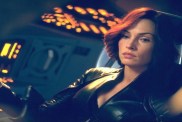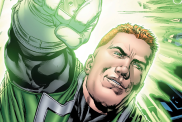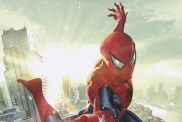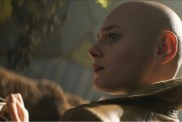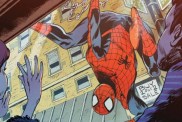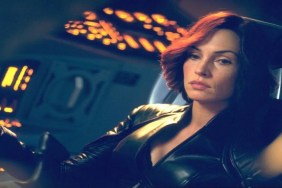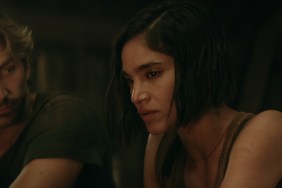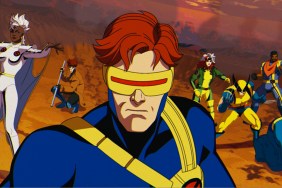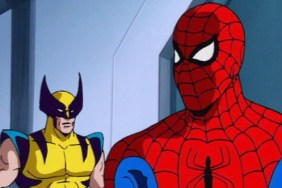
On November 30, 2005 I was invited by 20th Century Fox to visit the set of X-Men: The Last Stand. Unfortunately, my trip to Vancouver got off to a bumpy start when my flight arrived 15 minutes late. I was on a very tight schedule and was supposed to meet up with the rest of the press to head to the studio shortly after I arrived. But my schedule was further complicated when I arrived in customs and saw several hundred people in line in front of me. I stood in line for about 45 minutes while I pondered the imponderables, like, “Do the actors that come and work in Vancouver have to wait in these lines? What kind of reactions do they get when people see them?” Imagine my surprise when I looked at the end of the line and saw Kelsey Grammer standing there with everyone else wearing dark shades and, appropriately enough, a navy blue sweater. Nobody seemed to recognize him in the crowd. That answered my question.
After a frantic cab ride across town in rush hour, I arrived at Vancouver Film Studios. My cabbie and I were directed to the X-Men: The Last Stand offices. Along the way we saw where “Battlestar Galactica” was filming on the lot. As I walked in, I kind of stood there completely lost until a helpful soul said he’d guide me to the art department where the rest of the press were already in the middle of the tour with production designer Ed Verreaux. Along the way I saw “X-Men” paraphernalia everywhere. Each office had the cover of an “X-Men” comic under the name plates. Finally I arrived in the art department with the rest of the press.
I caught Ed Verreaux in the middle of his Q&A with the rest of the internet geeks. Ed has an incredible filmography. He worked on all the “Indiana Jones” films (and storyboarded “Raiders of the Lost Ark”), all of the “Back to the Future” films, “E.T. the Extra-Terrestrial,” “Poltergeist,” “Jurassic Park III,” “Big Trouble in Little China,” and more. Despite not having worked on the previous “X-Men” films, he’s jumped on board and taken over the role of production designer.
I looked around the room as Ed spoke and saw a number of interesting pieces of art. There were paintings of a Tractor Trailer, Juggernaut’s Prison, the Alaskan (how it was labeled) Bar Wolverine was found at in the first film, the Department of Mutant Affairs, Magneto’s Hideout, Worthington Industries, Worthington Labs, the Danger Room, Cure Clinics, a wood encampment, and more. Also there were numerous paintings and models of Alcatraz and the portion of the Golden Gate Bridge that was pulled to it by Magneto. There were also paintings of the X-Jet.
Ed was asked what his experience had been like working with director Brett Ratner and a tight time crunch? “It certainly has been arduous, but I say I’ve really enjoyed this project. All the people on the show are really professional and really nice. So there aren’t any mean spirits at all. Everybody’s very, very enthusiastic and hard working and it’s really been a lot of fun for me. I’m actually surprised because I’m LA based. I’ve got a family down there I don’t get to see very much and I thought it was going to be a lot harder. But it’s been really great. And I actually mean it.” (laughs)
Ed was asked how far into shooting they were at the time of our tour: “We are over 70% done with principal photography. But then there’s a huge amount of post to be done although that’s ongoing at this point and has been for a while.”
Which of these sets would he say was the most challenging to create? “Alcatraz. The Alcatraz set because it’s huge. And the concept that we came up with quite quickly. (Ed points to a small model of the set.) I built that on a Saturday based on talking with Brett on a Thursday. And this whole concept changed because this whole sequence was going to actually take place in Washington D.C. which was really problematic. And so we came up with this idea, ‘No, let’s do this sequence in Alcatraz instead.’ And so [we] very very very quickly did it and then began to draw it in Maya and found a location for it. We’d been looking for a location to use. It came together very quickly. Getting it in and getting it done where we could shoot it was a short, short kind of frame. We had to make a lot of quick decisions. Things like picking the colors of the siding. And the siding gets ordered and it comes from Calgary. ‘Is this color going to work?’ We’re not going to see it close up. But it’s those kinds of things where lots of times you can work stuff out. If you don’t quite like it, you can change it in this case. In another there was no changing. And you have to really make the right decisions the first time.”
Had they already started shooting on the Alcatraz set? “Oh yeah. We’ve been shooting for probably about three weeks, four weeks on the set. So we’ve had first unit and second unit on the set down there. You’ll see the bridge and all that too. The design of the bridge and designing the bridge’s broken piece like it’s falling down and cracking. Then also working the design to work with the action as well, so it’s like designing a three dimensional stage set for people. It isn’t just a background piece. It’s a piece that people have to jump down and run on and do all kinds of stuff.”
Ed was asked how the look of the film compares with the previous installments: “I think that it’s going to be more stylized as far as the acting and the cutting goes as opposed to the look because the look is somewhat, as I said, some of the stuff really can’t be too much changed like the established X-Jet, things like that, because it’s stuff we’ve already seen. [Ratner] would have liked, I know this for a fact cause we both talked about it, he really wanted to change the X-Jet a whole lot more, but it was just a financial thing. We couldn’t really change it that much.”
Does he have a whole new interior for the X-Jet? “No, it’s not all new. It’s been changed somewhat. I upgraded all the controls and stuff and made it look more like a real airplane. Just made the inside look a little bit more real, but that was all I had money for. I would have liked to have changed out the seats and all that stuff. That’s just my taste and that’s what Brett wanted to do, but we weren’t able to.”
After Ed finished speaking, we headed towards the actual sets through the offices. Along the way I spotted producer Ralph Winter’s office (filled with Fantastic Four toys), producer Lauren Schuler Donner’s office, and other recognizable names. We also passed the bathroom where someone had written an “X” in from of the “Men” sign.

When we arrived at the set, we found it locked and Ed Verreaux had to go back and get a key. We eventually got in and saw the large sound stage. In the middle of it was a mock-up of the X-Mansion. The hallways were recreated just like they were in the previous films. Our first stop in the halls was an office that doubled as a classroom for the Beast. Though everything was covered in sheets to keep dust off between shooting, you could see text books, artwork, and furniture in the rooms.
Ed continued the tour: “This is the interior of the X-Mansion. Or this is just what we built for this and we’ve changed things around with this place with the hall which you’ll all recognize. Unfortunately all the decoration is covered up with furniture blankets to protect it. I think you’ll get the idea when you see it. It basically, stylistically, mimics the mansion out at Vancouver Island. There’s a mansion out there called Royal Roads and that’s where they shot 2 and that’s where we shot 3 as well. And so for all of the close up inside stuff we’ve got it all here. And as you can see we have some of the set outside as well as inside parts to it so we can push into windows and see people doing stuff.”
Ed discussed the inside of the classroom: “So we have yet to shoot in this set. We just reconfigured a couple of rooms to build this room and it’s for another shot where Beast is teaching a class and he’s talking and as you can see there’s no ceiling cause hopefully we’re going to be down in here like that. This right now is going to be one of the classes. A casual lounge classroom.”
We then went back into the hallway and walked further down. We took a peek into Bobby Drake’s (aka Iceman) bedroom. Ed pointed out that there were little ice-like touches in the room. Ed also mentioned that they redressed the room several times to double as other student’s bedrooms.
“This is Bobby’s, Iceman’s, room. That also served as Kitty’s room and also as Rogue’s room. And we change it around, change the color, change the set dressing. Change the dressing out here if we need to come in and out of it.”
I asked Ed if there were any action scenes in these halls like in the last movie: “No, there won’t be any of that in this movie. The action all takes place outside. They don’t come in and attack the mansion like they did in 2.”
Ed discussed the decorations in the hallway: “The one thing I did do was I kind of pulled back the set dressing a little bit cause in 2 they used a lot of really, really modern stuff. And Brett and I talked about the idea that maybe it was a little bit more traditional this time. So we kept a little bit more like an old English school in a sense. So it’s just old. Old school stuff.”
We walked down the hall again to the next bedroom and entered into Wolverine’s room which had already been dismantled. “This was Logan’s room. And once again you can see we steal parts of the set and move things around all the time because as the needs change we can’t build everything, so we build parts of them and move them around.
Ed was asked if there were any unique touches to Logan’s room? “We had his bed and all this stuff. It was a very specific kind of a bed. We kept it very austere and simple and plain. Logan doesn’t have a lot of stuff. He doesn’t go for interior decorating.”
Does he try to sneak a lot of X’s into the sets? “Didn’t try to sneak a whole lot of X’s in this time. We had at one point designed a whole office for Xavier. There was going to be a whole sequence that took place in his office. It was going to be a set because there was going to be flying going on and all kinds of effects and things. And so I designed an X on the floor. It was going to be inlaid.”
We then departed the X-Mansion and walked into the next sound stage which contained something more interesting. There was a set dressed to look like the nearby Vancouver woods. There were trees and bushes everywhere. Ed told us it matched the forest that they’d be doing location shooting in. In the middle of it all was a portion of the X-Jet and it’s walkway. Verreaux said, “This is the bottom of the X-Jet fuselage. And here’s the ramp. There are the fins and all that. Everything else will be added digitally.” Ed told us this was actually the same set piece that was used in “X-Men 2”. He said a few of us could walk up the ramp and look inside. I immediately went up. As I walked up the shaky steps, I immediately noticed that the X-Men don’t seem to need handrails. But as I got up, I walked around with a couple of other press members. We were like kids in the candy store as we wandered around and saw all the seats in the jet interior. I joked that it looked like the X-Men’s school bus. As I came back down the steps, we were told by Ed that we better get off the jet because it wasn’t secured like he thought it was. As I looked up, I could see it swaying back and forth as the other press came down. I could just see the headlines: “X-Jet kills Internet Geeks on ‘X3’ Set” Somehow I don’t think that’s the publicity that Fox was looking for on this visit.
Ed discussed the scene that takes place here: “And so what also happens in this sequence is that they come down, they’ve landed in the forest. And it’s very foggy and they really can’t see. At first you’re in this very heavily fogged out space, and then they walk in the forest a little bit and Storm does one of her things and she clears the fog. And when she clears the fog we’re now on a location which is at a lake an hour east of here. These trees all come from the same area. All the trees and moss matches all the stuff out there.”
He spoke a little about the X-Jet ramp: “This won’t move. This sits here. This stays here. But the ramp can come down. But also you’ll notice that the ramp is longer than the opening. For some reason the way it was designed in “X2,” they designed the interior of the set with the shorter ramp bay than the exterior, but to have the ramp come down and not be real steep like a ship’s ladder, they had to have the ramp be longer so they cut away from it so you’ll see in “X2” you never see the ramp actually go up and nest in the fuselage. You’ll see coming down. You’ll see it starting to come down. And actually when you see in “X2″ these (steps) do this, you’ll see the treads rotate about 45 degrees, that’s visual effects. They don’t actually do that. There wasn’t actually time to mechanically build this to do that. It became a post thing. The nose, cockpit and all that are on another stage all wrapped up. I think we’re done with it. We did shoot X-Jet interior stuff earlier here on the stage before the forest was here. This was all facing the other way and there was a big green screen in front of it. So we had this aft section and the front section connected, but we don’t need that for this scene, so we just take it away. This is the aft or cargo bay. So if you had a lot of X-Men, this is where they’d all be sitting.”
We then proceeded to the next set on the lot which contained the lower portions of the X-Mansion. We walked in and found the infirmary set. There was a table in the middle of the room, a Dell monitor, and some medical equipment. Ed continued, “This is the infirmary. And we’ve already shot in it. We have to come back and shoot some more. This is similar to the infirmary in 1 and 2. It’s not the exact same layout, but it’s similar. Several things happen in here. There are actually some effects that go on in here. Some different kinds of psycho-kinetic things and stuff.”
We walked into the hall and saw the trademark door for Cerebro. Sadly, we will not see the interior of Cerebro in this film. Ed then showed us the elevator set piece. Again, a few of us got inside the elevator while Ed operated the door. We looked down at the buttons and saw listings for the various levels like Cerebro, the Hangar, and other levels.
Ed spoke to us about it: “And here’s the X-Elevator. The great thing about it is just by changing doors you can be going different ways and stuff which is what we’ve had to do because, of course, in the other movie they’d move things across the hallway as well. So we’ve done a lot of kind of playing musical doors here so that if this door is closed, you don’t know that that’s the infirmary. That could be something else. So in the infirmary sequence there was a regular X door over here. Now with that door closed, that becomes another space. So they’ll end up walking and getting into this and closing it and we’ll end up coming out either across the street in the other set or at Royal Roads.”

Having again fulfilled my inner geek, I stepped out of the elevator and proceeded down the hall with the other press. Ed pointed out that the doors were all used in the previous films and had been recycled for X-Men: The Last Stand. Speaking about the Cerebro door, Ed said, “This actually belongs to Fox and parts of this, like all the doors, were saved. The Cerebro door, that door cost $200,000 to make. So they’re not gonna throw that out. Some of these set pieces, as long as they intend to continue this franchise, they’re gonna want the door to Cerebro. They’re gonna want these doors. So all these doors actually were made for X1 and X2. A lot of the hallway we had to reproduce because the hallway bits were just chucked out in the trash. All the lighting rigs and all that stuff, all that’s new. Because, for whatever reason, they don’t save everything. So there were things like we had a scene in the Oval Office. We had several scenes which is on the stage next door. The Oval Office during the course of the two years since 2 and 3 have rented out several times and parts of it went missing. So we had to rebuild part of the Oval Office.”
We then walked a little ways over and found the interior set of a prison truck. Ed told us it was used in the film to transport Juggernaut and Multiple Man. The set was rigged to move up and down as if the truck were moving. Lying on the side were huge doors made out of foam and painted to look like metal. Written on them were “SMC” and “SMCM”. Ed was asked if they meant anything. He said they did, but he couldn’t remember what they were. He thought it was “Special Mutant Containment” and “Special Mutant Containment Module”. Ed mentioned that they had a real truck dressed like the prison truck, but this interior was used for filming.
That concluded our tour with Ed Verreaux. We hopped on a bus and then proceeded over to Mammoth Studios to see where the second unit was shooting. Continue reading in Part 2 of our X-Men: The Last Stand set visit report!
Source: Scott Chitwood

